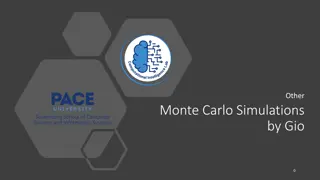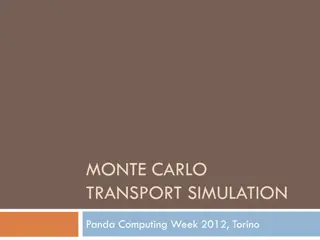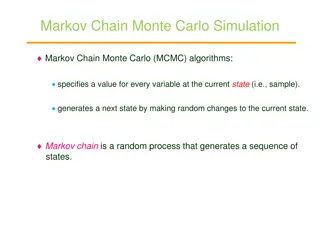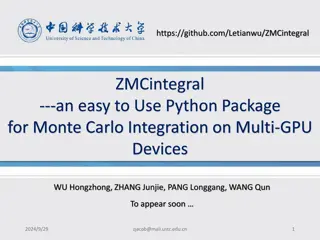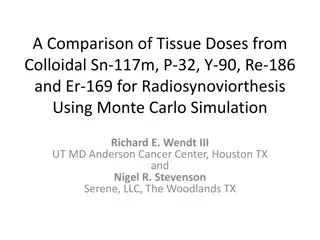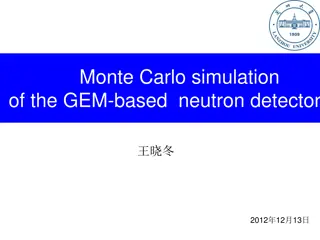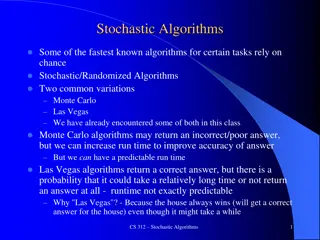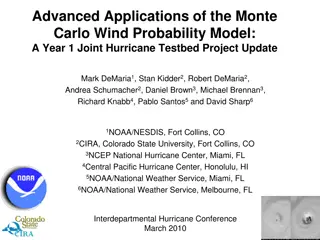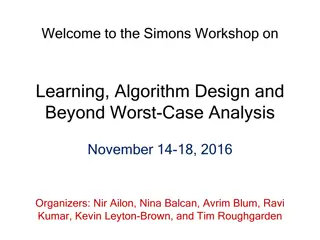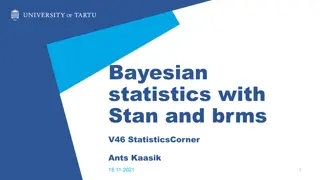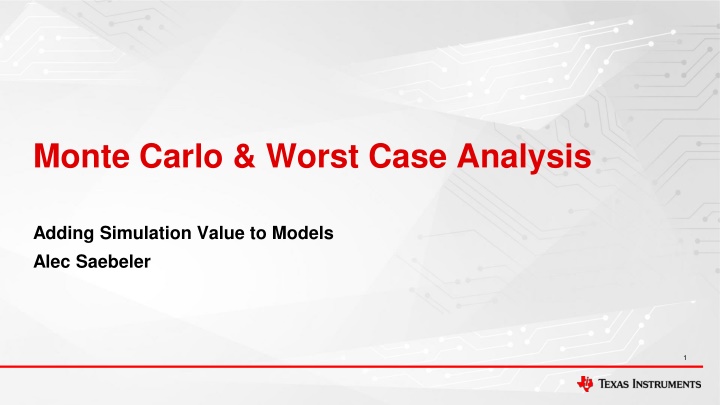
Adding Simulation Value to Models: Monte Carlo & Worst Case Analysis
Learn how Monte Carlo and Worst Case Analysis add simulation value to electronic models by varying component values and targeting worst-case scenarios. Understand the reasons behind each analysis method and how to implement them effectively for op-amp models like the LMH5401-SP. Recommended TI Precision Labs for mastering Op-Amp concepts.
Download Presentation

Please find below an Image/Link to download the presentation.
The content on the website is provided AS IS for your information and personal use only. It may not be sold, licensed, or shared on other websites without obtaining consent from the author. If you encounter any issues during the download, it is possible that the publisher has removed the file from their server.
You are allowed to download the files provided on this website for personal or commercial use, subject to the condition that they are used lawfully. All files are the property of their respective owners.
The content on the website is provided AS IS for your information and personal use only. It may not be sold, licensed, or shared on other websites without obtaining consent from the author.
E N D
Presentation Transcript
Monte Carlo & Worst Case Analysis Adding Simulation Value to Models Alec Saebeler 1
Monte Carlo Analysis: Reason Monte Carlo -> Randomly varies component values by changing device parameters For resistors, this is typically tolerance for the resistance value Usually a given tolerance or range of tolerances is specified, sometimes with specific lot or deviation values (lot being a major percent difference across a run, and deviation being a small difference for each unit) For more complicated devices, such as op-amps, the op-amp parameters often cannot be varied by using a built-in Monte Carlo analysis feature, like the one present in PSPICE. Rather, the user will either need to manually edit the model file, or find other ways of varying op-amp parameters external to the model. Monte Carlo allows for a statistical dataset on the impact of component value variance across the circuit/system 2
Worst Case Analysis: Reason Worst Case -> Targets worst possible performance by following maximum/minimum targets of specified fields. Temperature range and component tolerance are typically used in worst-case analysis. Unlike Monte Carlo, which randomly varies multiple parameters, worst-case analysis only varies a single parameter per run. Worst Case can be utilized as a targeted sub-analysis for Monte Carlo when Monte Carlo analysis is not viable or easily implemented. For op-amps, a pseudo-Monte Carlo/Worst-Case analysis can be implemented external to the op-amp models. 3
For the LMH5401-SP Vos -> TYP = +/- 0. 5mV; Min/Max = +/- 5mV The existing LMH5401-SP does not strictly model Vos or Ib across temperature. To model Vos, Ib, or other op-amp parameters, you must first characterize the baseline model performance. Then, you must add in passive components or DC sources to provide the extension in functionality that is desired. TI models are not designed to have user-variable internal tolerances. However, a user is welcome to externally stimulate or internally modify a model parameter for testing, as long as the user understands the assumed risk of the model not behaving as expected. Adding an external offset to Vos results in a more accurate Vos at extreme temperatures, for example. Example: DC Parameters Two parameters of op- amps which can be modelled successfully external to the op-amp model are offset voltage (Vos) and input bias current (Ib) Discrete DC sources can be used to extend a basic op-amp model into a Monte Carlo/Worst-Case capable model 4
Recommended: TI Precision Labs As this extension of model ability does involve some technical choices and knowledge, TI s Precision Labs training series on Op-Amps is recommended If you know the concepts of Vos and Ib, as well as how they interact with an op-amp in simulation, you can proceed without the training 5
Example: OPA830 For the OPA830, the typical value of Vos = +/-1.5mV. The necessary external DC voltage source needs to be 7.1mV to reach the highest temperature maximum of 8.6mV; the voltage source is added into the noninverting node. The typical Ib = 5uA, to reach the maximum, DC current sources must add 8uA to each op-amp input to reach Ib_max = 13uA. You will need a DC current source for each op-amp input, for a total of two DC current sources Voltage source goes into same input as input signal 6
General Guidelines Some models will have explicit values for Vos and Ib represented in the model; others will have Vos and Ib as functions of the input common mode voltage, like the OPA2863. Selection of the proper value for the external sources depends on the accepted baseline Vos and Ib of the model you are working with. For models that do not have the values of Vos and Ib listed in the model, you will need to simulate a baseline to find your typical values. First test the model in your circuit setup without any temperature or tolerance variation, and measure the Vos and Ib. Place an ammeter at each input to the op-amp, and a voltmeter across the inputs These values form your baseline. If you are unable to measure Vos, you may use the datasheet TYP value as the assumed amount modelled in the op-amp model. 7
General Guidelines Pt. 2 Take this value and subtract from the maximum or minimum value of Vos or Ib shown in the datasheet. For positive datasheet Ib, current sources go into the input nodes. For negative datasheet Ib, current sources sink current from the input nodes. This represents the type of input structure, such as PNP vs. NPN transistors. For Vos, if the model does not select a positive or negative polarity for Vos, you may choose the one that best suits your application. If you are trying for absolute worst, adding a same-polarity quantity to a quantity results in the greatest magnitude, which is typically desired for worst-case analysis. 8
General Guidelines Pt. 3 When considering Worst-Case analysis, use of temperature extremes such as 125 C or -40 C is common. These temperatures often have minimum or maximum values for Vos, Ib, etc. To effectively explore worst-case behavior, use the min/max values from the extreme temperatures to add independent DC sources to your circuit. You may perform a Monte-Carlo on resistors, capacitors, etc while leaving the DC sources present in the circuit. This method allows for a close approximation of op-amp behavior at extreme temperatures, since the offset added by the DC sources will force the op-amp to behave at its min/max for a spec 9


